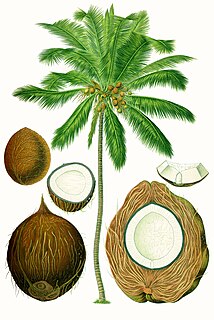
The coconut tree is a member of the palm tree family (Arecaceae) and the only living species of the genus Cocos. The term "coconut" can refer to the whole coconut palm, the seed, or the fruit, which botanically is a drupe, not a nut. The name comes from the old Portuguese word coco, meaning "head" or "skull", after the three indentations on the coconut shell that resemble facial features. They are ubiquitous in coastal tropical regions and are a cultural icon of the tropics.

Nelumbo is a genus of aquatic plants with large, showy flowers. Members are commonly called lotus, though "lotus" is a name also applied to various other plants and plant groups, including the unrelated genus Lotus. Members outwardly resemble those in the family Nymphaeaceae, but Nelumbo is actually very distant to Nymphaeaceae. "Nelumbo" is derived from the Sinhalese word Sinhala: නෙළුම් neḷum, the name for the lotus Nelumbo nucifera.

Nelumbo nucifera, also known as Indian lotus, sacred lotus, or simply lotus, is one of two extant species of aquatic plant in the family Nelumbonaceae. It is often colloquially called a water lily.

Torreya nucifera is a slow-growing, coniferous tree native to southern Japan and to South Korea's Jeju Island. It is also called kaya (榧)Japanese torreya or Japanese nutmeg-yew.

Torreya is a genus of conifers comprising six or seven species placed the family Taxaceae, though sometimes formerly placed in Cephalotaxaceae. Four species are native to eastern Asia; the other two are native to North America. They are small to medium-sized evergreen trees reaching 5–20 m, rarely 25 m, tall. Common names include nutmeg yew.
Sacred lotus may refer to:
Amblyseiulella amanoi is a species of mite in the family Phytoseiidae.
Amblyseiulella baltazarae is a species of mite in the family Phytoseiidae.
Amblyseiulella chombongenis is a species of mite in the family Phytoseiidae.
Amblyseiulella domatorum is a species of mite in the family Phytoseiidae.
Amblyseiulella odowdi is a species of mite in the family Phytoseiidae.
Amblyseiulella omei is a species of mite in the family Phytoseiidae.
Amblyseiulella paraheveae is a species of mite in the family Phytoseiidae.
Amblyseiulella prunii is a species of mite in the family Phytoseiidae.
Amblyseiulella thoi is a species of mite in the family Phytoseiidae.
Amblyseiulella yaeyamana is a species of mite in the family Phytoseiidae.

Rhynchophorus, or common name palm weevil, is a genus of beetles in the weevil family, Curculionidae. Palm weevils are major pests of various trees in the family Arecaceae throughout the tropics including: coconut, Areca catechu, species of the genus Phoenix, and Metroxylon sagu.

The cuisine of Nauru is the traditional cuisine of the island state on the Pacific Ocean. Due to the diversity of the country's inhabitants, the cuisine is highly diverse.





